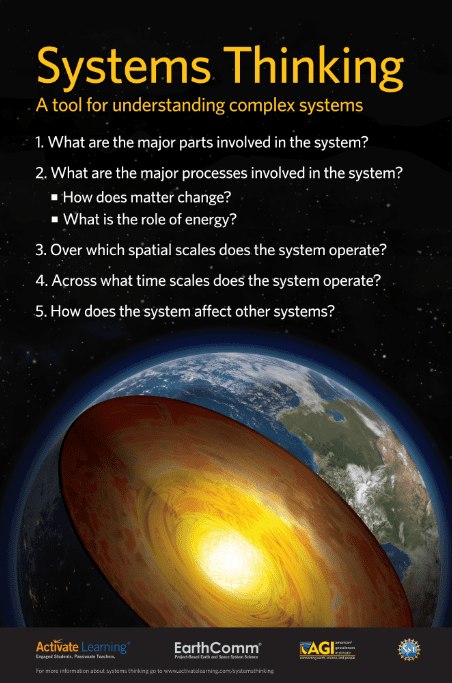What is Systems Thinking?

Systems Thinking: A Tool for Understanding Complex Systems
Systems thinking plays an important role in how science is being taught today and “Systems and Systems Models” is one of the crosscutting concepts described in the Framework for K-12 Science Education*, which is the basis for the Next Generation Science Standards.
*National Research Council. (2012). A Framework for K-12 Science Education: Practices, Crosscutting Concepts, and Core Ideas. Committee on a Conceptual Framework for New K-12 Science Education Standards. Board on Science Education, Division of Behavioral and Social Sciences and Education. Washington, DC: The National Academies Press.
What is Systems Thinking?
Systems thinking is essentially a way of analyzing complex situations and events. This makes it a useful tool in many science areas. Systems thinking calls for the consideration of a variety of questions, including those on the poster shown above, and several other steps that outline the important features, interactions, and components of the system, as well as the key factors that affect its processes and outcomes.
Systems thinking often begins with the definition of the system to be studied. Since systems may connected to other systems through the flow of matter and/or energy, the study of a system calls for the delineation of its boundaries.
This can be challenging. According to A Framework for K-12 Science Education:
Although any real system smaller than the entire universe interacts with and is dependent on other (external) systems, it is often useful to conceptually isolate a single system for study. To do this, scientists and engineers imagine an artificial boundary between the system in question and everything else. They then examine the system in detail while treating the effects of things outside the boundary as either forces acting on the system or flows of matter and energy across it-for example, the gravitational force due to Earth on a book lying on a table or the carbon dioxide expelled by an organism. Consideration of flows into and out of the system is a crucial element of system design. In the laboratory or even in field research, the extent to which a system under study can be physically isolated or external conditions controlled is an important element of the design of an investigation and interpretation of results.
Often, the parts of a system are interdependent, and each one depends on or supports the functioning of the system’s other parts. Yet the properties and behavior of the whole system can be very different from those of any of its parts, and large systems may have emergent properties, such as the shape of a tree, that cannot be predicted in detail from knowledge about the components and their interactions. Things viewed as subsystems at one scale may themselves be viewed as whole systems at a smaller scale. For example, the circulatory system can be seen as an entity in itself or as a subsystem of the entire human body; a molecule can be studied as a stable configuration of atoms but also as a subsystem of a cell or a gas.
Framework for K-12 Science Education, p. 92
What this indicates is that systems thinking provides guidance for how to approach analyzing situations and events-the questions to ask, the features to attend to, and the interactions to monitor. Such guidance makes the analysis of complex situations and events more accessible to scientists, and to students.
How to Introduce Systems Thinking to Students
Both the Framework for K-12 Science Education and the NGSS call on educators to help students to be able to think in terms of “systems and system models” in various contexts. This means that they should learn how to “define the system under study-specifying its boundaries and making explicit a model of that system”. In this way, systems thinking “provides tools for understanding and testing ideas that are applicable throughout science and engineering” (NGSS, Appendix G).
To help students develop skills in systems thinking, it is often helpful to begin with a system that is familiar to them, and limited in its complexity. The questions that appear on the poster are a useful starting place for introducing systems thinking to students.
A familiar machine such as a stapler, a pen, or a flashlight can be used for this purpose (although it is important to know that designed systems-technologies-are in many ways different from natural systems). Students can work in teams to draw a diagram of how the system works, and then annotate the diagram to highlight the answers to the five systems thinking questions on the poster. This will give them practice with this form of analysis, and they can then move to more challenging content-such as a playground, a car, or a cellular phone.
Another approach to introducing systems thinking is to show students a natural landscape and ask them to consider the questions from the poster. Students ideas will vary, but they are likely to focus on elements that are commonly considered the parts (subsystems) of the Earth system; The atmosphere, biosphere, cryosphere, geosphere, and hydrosphere. Those are defined below, on this page from EarthComm ®.

As students become more familiar with systems thinking, they can start to apply it to highly complex systems such as a volcano, a hurricane or a living thing. In a lesson, they can begin by expressing the answers to the systems thinking questions using their prior knowledge. Then, as they learn more about the system, they can revise their answers using their new knowledge.
How is Systems Thinking applied in various sciences?
In addition to Earth systems, other topics in science can be analyzed using systems thinking. EarthComm® is an Earth and space science curriculum developed by the American Geosciences Institute with funding from the National Science Foundation. It applies a systems thinking approach. The orientation that EarthComm provides to systems thinking states:
Systems thinking can be applied to any kind of system. There are engineering systems, social systems, conceptual systems, natural systems, and so on. Even your school can be considered a system. Systems thinking is simply a method for understanding the relationships and connections between parts of a larger whole. It helps people analyze how things work, and simplify complex things by focusing on their most essential characteristics. It is a useful approach for looking at any problem you might need to solve.
(EarthComm, p. NS10)
In biology, an organism is a system, which is also made up of several subsystems. That organism may be part of a larger system–an ecosystem–containing living things from all the kingdoms, which are interacting in various ways–such as through food chains and food webs. Energy moves through the ecosystem such as from the sun, to plants, and then to animals and other living things. The energy in this system is largely moved as a component of matter that is transferred in various ways from one organism to another. The energy may be in the chemical bonds of sugars, for example. This shows that systems thinking can also be applied in chemistry.
Consider the structure of matter starting with subatomic particles. These subatomic particles can be thought of as systems that interact forming atoms, which interact and form molecules. Molecules also interact with each other in chemical reactions–which results in the movement of energy and matter, and leads to the formation of different molecules as the atoms are rearranged. Many chemical processes take place in specific contexts, such as the formation of rocks in geology, and meteorological processes such as the formation of ozone in the upper atmosphere. Ozone is important in that it absorbs ultraviolet radiation that can be damaging to living things. The interactions of ozone and ultraviolet radiation can also be analyzed using systems thinking and principles from physics.
As already stated, systems thinking can also be applied to familiar technologies in the world around us, and just as EarthComm® does this in Earth and space science, another curriculum Active Physics applies systems thinking in various ways to help students learn Physics. For example, in the chapter titled Electricity for Everyone, students design an appliance package for a family that is powered by a wind-driven generator. The wind generator providing electricity is one system. Each of the appliances can be considered another system. The distribution of electricity to each appliance through the use of switches, circuits, and fuses is another system. All of these systems interact in what can be considered a larger, integrated system.
A sample of how the five systems thinking questions can be applied is given in the box below, which is an excerpt from EarthComm’s chapter on Winds, Oceans, Weather, and Climate:

Sample of systems thinking analysis from EarthComm, Chapter 4.
* * * * * * *





